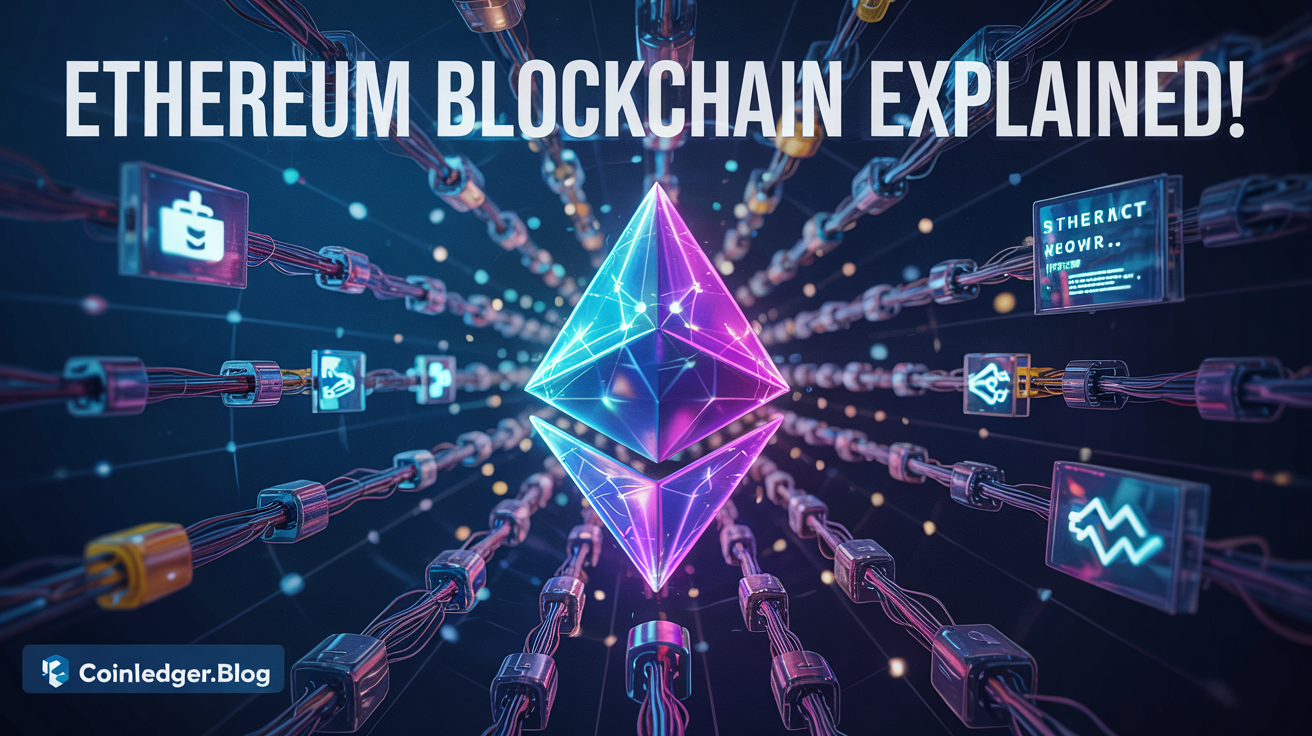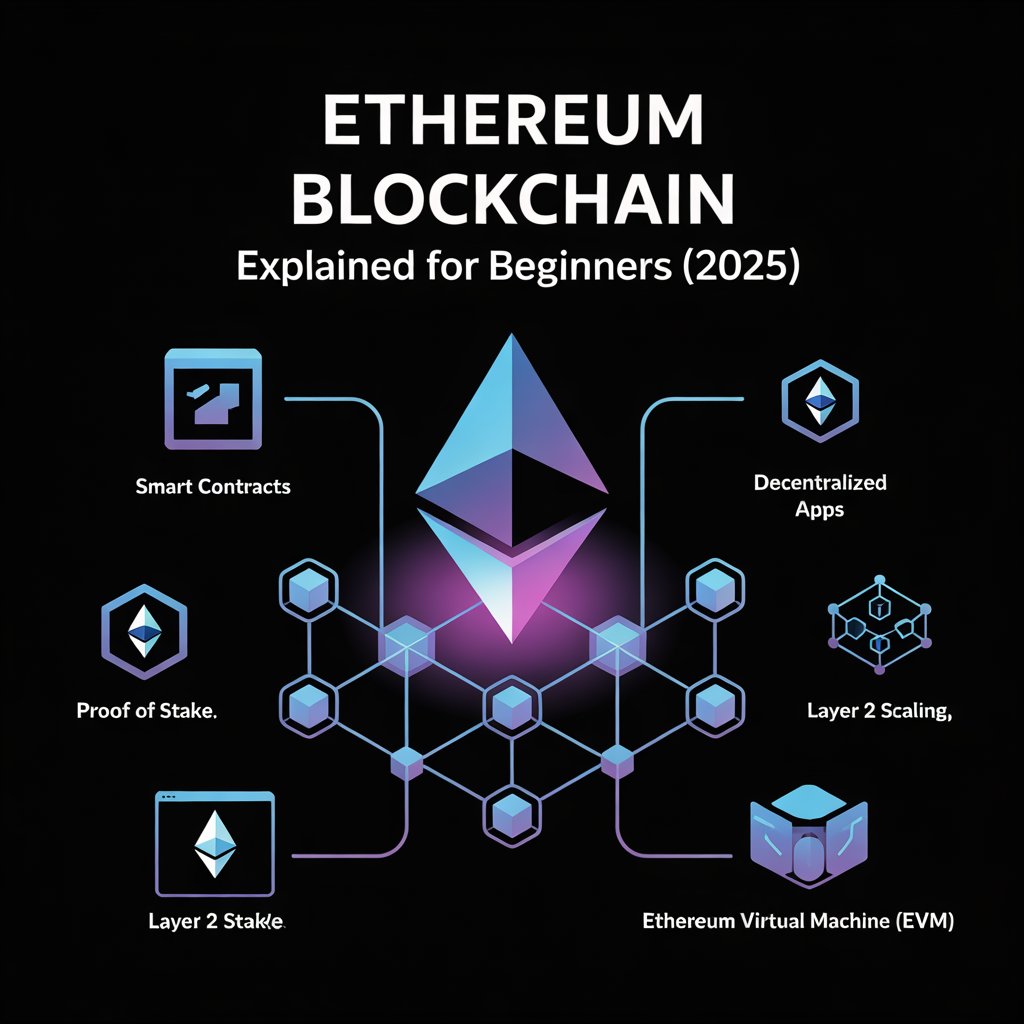
Download Complete Guide in PDF File
🌐 Ethereum for beginners (2025), What It Is & How It Works Explained Simply

🧠 Introduction
Ethereum for beginners is one of the most powerful and widely used blockchain platforms in the world. If you’ve heard of cryptocurrencies or smart contracts, chances are Ethereum has been mentioned. Launched in 2015, Ethereum is more than just a digital currency: it’s a decentralized platform where developers can build applications, users can conduct secure transactions, and innovations like NFTs and DeFi (decentralized finance) thrive.
In 2025, Ethereum remains a key player in the blockchain world thanks to major updates and widespread adoption. This guide will help you understand what Ethereum is, how it works, and why it’s important, in simple terms.
Ethereum blockchain explained for beginners (2025): Ethereum is more than just a cryptocurrency — it’s a powerful blockchain platform designed to support smart contracts, decentralized apps (dApps), and tokens like those based on the Ethereum network ERC-20 standard. While many ask “Is Ethereum a cryptocurrency?” the answer is: Ether (ETH) is the native cryptocurrency, while Ethereum refers to the entire blockchain ecosystem. From understanding how Ethereum makes money through gas fees, to learning the difference between Bitcoin and Ethereum, or even how the Ethereum blockchain API enables developers to build Web3 apps — this guide covers it all. We’ll also explain what the Ethereum blockchain is, give real Ethereum blockchain examples, compare Ether vs Ethereum, and explore the top Ethereum-based coins in 2025.
📜 A Brief History of Ethereum for beginners
Ethereum was created by a team of developers led by Vitalik Buterin, a young programmer who believed that Bitcoin was great, but limited. He wanted to create a blockchain that could do more than just manage transactions: one that could execute code, power applications, and make decisions without a central authority.
2015: Ethereum officially launched.
2016: The DAO hack occurred, causing a major split (Ethereum vs. Ethereum Classic).
2022: Ethereum switched from Proof-of-Work to Proof-of-Stake through a major upgrade called The Merge.
2025: Ethereum now powers thousands of applications, with scalability improvements and lower gas fees thanks to Layer 2 solutions like Arbitrum and Optimism.
⚙️ How Ethereum Works:
Ethereum functions as a global computer. Instead of a central server, it runs on thousands of decentralized nodes (computers) around the world. Anyone can use it to:
- Send and receive ETH (its native currency)
- Implement smart contracts
- Develop decentralized applications (dApps)
- Store NFTs
- Use DeFi platforms to lend, borrow, and trade
Ethereum uses its own currency, called Ether (ETH), to pay for actions on the network (so-called gas fees).
🔑 Key Features of Ethereum (2025)
1. Smart Contracts: Self-executing programs that run when conditions are met. No intermediaries are needed: the code does the work.
2. Decentralized Applications (dApps): Applications that reside on the Ethereum network and cannot be controlled or disabled by any party.
3. Proof of Stake (PoS): Ethereum now uses PoS instead of mining, which saves energy and allows users to earn rewards by staking ETH.
4. Layer 2 Scalability: With platforms like Arbitrum, Optimism, and zkSync, Ethereum can process more transactions faster and with lower fees.
5. Ethereum Virtual Machine (EVM): The engine that runs smart contracts and ensures everything works exactly as programmed.
6. Broad Ecosystem: Ethereum supports DeFi applications, NFT marketplaces, Web3 tools, and now even AI-related applications.
✅ Advantages of Ethereum:
🌍 1. Wide Adoption
Used by millions of people around the world, with strong community and developer support.
🔐 2. Secure and Decentralized
No central control; transactions and contracts are tamper-proof and transparent.
🧱 3. Flexible Development Platform
You can build virtually anything, from games and social applications to financial platforms, directly on the Ethereum blockchain.
💰 4. Staking Earnings
Users can stake ETH and earn passive rewards.
🔧 5. Constant Updates
The Ethereum team is constantly working on improvements, such as lower gas fees, faster speeds, and improved security.
❌ Disadvantages of Ethereum:
💸 1. High Gas Fees (Still Present on Layer 1)
Fees can be high on the mainnet, especially during peak times.
🕒 2. Slow Transactions (Compared to Newer Networks)
Although improved now, Ethereum is still slower than some modern blockchains, such as Solana or Sui.
🧪 3. Complex for Beginners
Smart contracts, staking, and gas fees can be confusing for beginners.
🔧 4. Scalability is still under development
While Layer 2 helps, full scalability is still being developed on Ethereum’s roadmap.
Download Complete Guide in PDF File
🧭 Conclusion:
Ethereum is more than just a cryptocurrency: it’s a complete platform for building the future of the internet. With its powerful smart contracts, vibrant community, and continuous updates, Ethereum will remain the backbone of the decentralized world in 2025.
If you’re new to crypto, understanding Ethereum is a great first step. Whether you’re looking to invest, develop, or simply expand your network, Ethereum is a great place to start.
🔑 Quick Recap:
-
Ethereum = programmable blockchain
-
ETH = the coin used on the network
-
Smart contracts make apps run automatically
-
Staking helps earn rewards
-
Still improving, but already powerful



No Comments